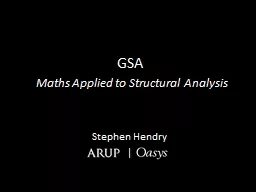PPT-GSA Maths Applied to Structural Analysis
Author : barbara | Published Date : 2021-01-28
Stephen Hendry Engineering problems are underdefined there are many solutions good bad and indifferent The art is to arrive at a good solution This is a creative
Presentation Embed Code
Download Presentation
Download Presentation The PPT/PDF document "GSA Maths Applied to Structural Analy..." is the property of its rightful owner. Permission is granted to download and print the materials on this website for personal, non-commercial use only, and to display it on your personal computer provided you do not modify the materials and that you retain all copyright notices contained in the materials. By downloading content from our website, you accept the terms of this agreement.
GSA Maths Applied to Structural Analysis: Transcript
Download Rules Of Document
"GSA Maths Applied to Structural Analysis"The content belongs to its owner. You may download and print it for personal use, without modification, and keep all copyright notices. By downloading, you agree to these terms.
Related Documents














